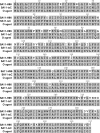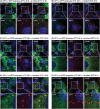A Temperature-Sensitive Lesion in the N-Terminal Domain of the Rotavirus Polymerase Affects Its Intracellular Localization and Enzymatic Activity
- PMID: 28100623
- PMCID: PMC5355613
- DOI: 10.1128/JVI.00062-17
A Temperature-Sensitive Lesion in the N-Terminal Domain of the Rotavirus Polymerase Affects Its Intracellular Localization and Enzymatic Activity
Abstract
Temperature-sensitive (ts) mutants of simian rotavirus (RV) strain SA11 have been previously created to investigate the functions of viral proteins during replication. One mutant, SA11-tsC, has a mutation that maps to the gene encoding the VP1 polymerase and shows diminished growth and RNA synthesis at 39°C compared to that at 31°C. In the present study, we sequenced all 11 genes of SA11-tsC, confirming the presence of an L138P mutation in the VP1 N-terminal domain and identifying 52 additional mutations in four other viral proteins (VP4, VP7, NSP1, and NSP2). To investigate whether the L138P mutation induces a ts phenotype in VP1 outside the SA11-tsC genetic context, we employed ectopic expression systems. Specifically, we tested whether the L138P mutation affects the ability of VP1 to localize to viroplasms, which are the sites of RV RNA synthesis, by expressing the mutant form as a green fluorescent protein (GFP) fusion protein (VP1L138P-GFP) (i) in wild-type SA11-infected cells or (ii) in uninfected cells along with viroplasm-forming proteins NSP2 and NSP5. We found that VP1L138P-GFP localized to viroplasms and interacted with NSP2 and/or NSP5 at 31°C but not at 39°C. Next, we tested the enzymatic activity of a recombinant mutant polymerase (rVP1L138P) in vitro and found that it synthesized less RNA at 39°C than at 31°C, as well as less RNA than the control at all temperatures. Together, these results provide a mechanistic basis for the ts phenotype of SA11-tsC and raise important questions about the role of leucine 138 in supporting key protein interactions and the catalytic function of the VP1 polymerase.IMPORTANCE RVs cause diarrhea in the young of many animal species, including humans. Despite their medical and economic importance, gaps in knowledge exist about how these viruses replicate inside host cells. Previously, a mutant simian RV (SA11-tsC) that replicates worse at higher temperatures was identified. This virus has an amino acid mutation in VP1, which is the enzyme responsible for copying the viral RNA genome. The mutation is located in a poorly understood region of the polymerase called the N-terminal domain. In this study, we determined that the mutation reduces the ability of VP1 to properly localize within infected cells at high temperatures, as well as reduced the ability of the enzyme to copy viral RNA in a test tube. The results of this study explain the temperature sensitivity of SA11-tsC and shed new light on functional protein-protein interaction sites of VP1.
Keywords: RNA synthesis; VP1; polymerase; rotavirus; temperature-sensitive mutant; viroplasm.
Copyright © 2017 American Society for Microbiology.
Figures









Similar articles
-
Reverse genetic engineering of simian rotaviruses with temperature-sensitive lesions in VP1, VP2, and VP6.Virus Res. 2021 Sep;302:198488. doi: 10.1016/j.virusres.2021.198488. Epub 2021 Jun 17. Virus Res. 2021. PMID: 34146610 Free PMC article.
-
Interaction of rotavirus polymerase VP1 with nonstructural protein NSP5 is stronger than that with NSP2.J Virol. 2007 Mar;81(5):2128-37. doi: 10.1128/JVI.01494-06. Epub 2006 Dec 20. J Virol. 2007. PMID: 17182692 Free PMC article.
-
Full genomic analysis of a simian SA11-like G3P[2] rotavirus strain isolated from an asymptomatic infant: identification of novel VP1, VP6 and NSP4 genotypes.Infect Genet Evol. 2011 Jan;11(1):57-63. doi: 10.1016/j.meegid.2010.10.010. Epub 2010 Oct 28. Infect Genet Evol. 2011. PMID: 21035567
-
The Role of the Host Cytoskeleton in the Formation and Dynamics of Rotavirus Viroplasms.Viruses. 2024 Apr 25;16(5):668. doi: 10.3390/v16050668. Viruses. 2024. PMID: 38793550 Free PMC article. Review.
-
Plasmid-based reverse genetics for probing phosphorylation-dependent viroplasm formation in rotaviruses.Virus Res. 2021 Jan 2;291:198193. doi: 10.1016/j.virusres.2020.198193. Epub 2020 Oct 11. Virus Res. 2021. PMID: 33053412 Free PMC article. Review.
Cited by
-
Principles of RNA recruitment to viral ribonucleoprotein condensates in a segmented dsRNA virus.Elife. 2023 Jan 26;12:e68670. doi: 10.7554/eLife.68670. Elife. 2023. PMID: 36700549 Free PMC article.
-
In Vitro Double-Stranded RNA Synthesis by Rotavirus Polymerase Mutants with Lesions at Core Shell Contact Sites.J Virol. 2019 Sep 30;93(20):e01049-19. doi: 10.1128/JVI.01049-19. Print 2019 Oct 15. J Virol. 2019. PMID: 31341048 Free PMC article.
-
Genetic determinants restricting the reassortment of heterologous NSP2 genes into the simian rotavirus SA11 genome.Sci Rep. 2017 Aug 24;7(1):9301. doi: 10.1038/s41598-017-08068-w. Sci Rep. 2017. PMID: 28839154 Free PMC article.
-
Understanding the penetrance of intrinsic protein disorder in rotavirus proteome.Int J Biol Macromol. 2020 Feb 1;144:892-908. doi: 10.1016/j.ijbiomac.2019.09.166. Epub 2019 Nov 15. Int J Biol Macromol. 2020. PMID: 31739058 Free PMC article.
-
Group A Rotavirus VP1 Polymerase and VP2 Core Shell Proteins: Intergenotypic Sequence Variation and In Vitro Functional Compatibility.J Virol. 2019 Jan 4;93(2):e01642-18. doi: 10.1128/JVI.01642-18. Print 2019 Jan 15. J Virol. 2019. PMID: 30355692 Free PMC article.
References
-
- Estes MK, Kapikian AZ. 2006. Rotaviruses and their replication, p 1917–1974. In Knipe DM, Howley PM (ed), Fields virology, 5th ed Lippincott Williams & Wilkins, Philadelphia, PA.
-
- Tate JE, Burton AH, Boschi-Pinto C, Parashar UD, World Health Organization-Coordinated Global Rotavirus Surveillance Network. 2016. Global, regional, and national estimates of rotavirus mortality in children <5 years of age, 2000–2013. Clin Infect Dis 62(Suppl 2):S96–S105. doi:10.1093/cid/civ1013. - DOI - PMC - PubMed
MeSH terms
Substances
Grants and funding
LinkOut - more resources
Full Text Sources
Other Literature Sources

